![]()
![]()

NOW 50% OFF all of Ann Savageau’s works displayed
in Coleman Hall.
 Environmental Collaboration Poles
Environmental Collaboration Poles
Ann Savageau’s Totemic poles are the result of a creative collaboration between the artist and bark beetles of the Sierra Nevada Mountains. As Savageau tells us, “The larvae of each species make their own distinctive tunnel patterns. I enhanced their beautiful patterns with metallic paint and playful top made from seed pods.”
Identification of beetles creating the larval galleries in Totems:
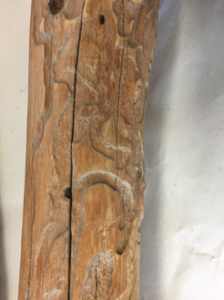
Pole 1: Several larval mines of a Roundheaded Borer (Cerambycidae) that begin in the phloem and outer xylem and then descend into the xylem to complete development (feed and pupate). A typical species on fir branches or stems would be Tetropium abietis Fall, which occurs from Washington to California in Abies. These only live a year or two in the wood.
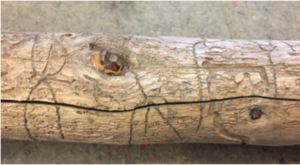
Pole 2: Perhaps the star-shaped (stellate) galleries of Pityogenes species [could be Pityogenes carinulatus (LeConte), Pityogenes fossifrons (LeConte), or Pityogenes knechteli Swaine], which all colonize branches and upper stem pieces of large pines or stems of small pines in California. If this wood piece was from lodgepole pine, the most likely species would be P. knechteli. the tops and limbs of dying fir or Douglas-fir. It occurs at high elevations from British Columbia and Idaho to California. There is also a larger diameter larval mine of a flatheaded borer (Buprestidae) on this piece of wood (on the right side of the image).
Also has a large gallery of possibly the Douglas-fir engraver, Scolytus unispinosus LeConte, about 1/3 of the way from the base. It occurs from British Columbia, Idaho, and Montana to California. It colonizes weakened, injured, dying, and recently dead young Douglas-fir trees. Can also colonize the branches of larger trees. The adults are less than 3 mm long. The egg gallery is oriented longitudinally with the grain of the wood.
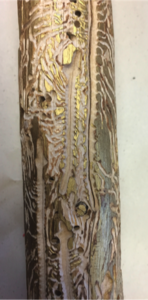
Pole 3: Perhaps the Douglas-fir engraver, Scolytus unispinosus LeConte, which occurs from British Columbia, Idaho, and Montana to California. It colonizes weakened, injured, dying, and recently dead young Douglas-fir trees. Can also colonize the branches of larger trees. The adults are less than 3 mm long. The egg gallery is oriented longitu- dinally with the grain of the wood.
**Note: Pole 4 is not depicted.
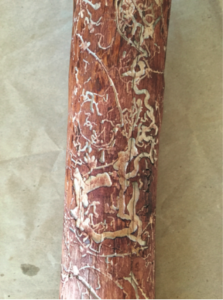
Pole 5: Perhaps the star-shaped (stellate) galleries of Pityogenes species [could be Pityogenes carinulatus (LeConte), Pityo- genes fossifrons (LeConte), or Pityogenes knechteli Swaine], which all colonize branches and upper stem pieces of large pines or stems of small pines in California. If this wood piece was from lodgepole pine, the most likely species would be P. knechteli. the tops and limbs of dying fir or Douglas-fir. It occurs at high elevations from British Colum- bia and Idaho to California. There is also a larger diameter larval mine of a flatheaded borer (Buprestidae) on this piece of wood (on the right side of the image).
Perhaps the Douglas-fir engraver, Scolytus unispinosus LeConte, which occurs from British Columbia, Idaho, and Montana to California. It colonizes weakened, injured, dying, and recently dead young Douglas-fir trees. Can also colonize the branches of larger trees. The adults are less than 3 mm long. The egg gallery is oriented longitu- dinally with the grain of the wood.
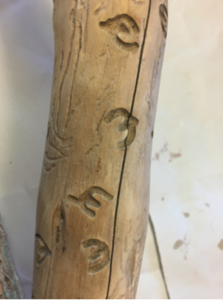
Pole 6: Scotlyus subscaber: A fir engraver, Scolytus subscaber, occurs from British Columbia and Idaho to California. It colonizes the suppressed branches of white fir, red fir, and grand fir trees. It is one of the larger species of Scolytus in western North America. The E-shaped gallery is unique among the bark beetles and diagnos- tic to species.
The Artist:
Ann Savageau is an environmental artist who creates mixed-media sculpture and installations. Her work deals with the natural world, human culture, and their intersection. Her current interests include global warming and environmental destruction; consumer culture and wasteful consumption; and artistic transformations of waste. Ann’s Stanford anthropological training, her interest in the natural world, and the many places she has lived are reflected in her art.
Background:
Ann received her A.B. from Stanford University, and her M.F.A. from Wayne State University. She taught at the University of Michigan Residential College from 1978-2002, and she joined the faculty at the University of California, Davis, in 2003. She retired as Full Professor of Design in 2014, and she currently works as a full time studio artist. Ann has exhibited her work in over 70 exhibitions, both nationally and internationally. She has given numerous lectures and workshops and has juried many exhibitions. More information is available at annsavageau.com.
In addition to Ann Savageau’s work, two other artists are also featured in the Coleman Hall fundraiser for Gualala Arts. Follow the links to information about Sharon Nickodem and Susan Nutter. Stop in and see them all!
 Gualala Arts Promoting public interest and participation in the arts since 1961
Gualala Arts Promoting public interest and participation in the arts since 1961